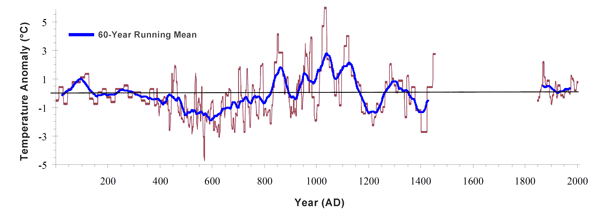Reference
Moschen, R., Kuhl, N., Peters, S., Vos, H. and Lucke, A. 2011. Temperature variability at Durres Maar, Germany during the Migration Period and at High Medieval Times, inferred from stable carbon isotopes of Sphagnum cellulose. Climate of the Past 7: 1011-1026.
Description
Moschen et al. present "a high resolution reconstruction of local growing season temperature anomalies at Durres Maar, Germany [50°52'N, 6°53'E], spanning the last two millennia," which was "derived from a stable carbon isotope time series of cellulose chemically extracted from Sphagnum leaves (δ13Ccellulose) separated from a kettle-hole peat deposit of several meters thickness," where the temperature reconstruction was based on the temperature dependency of Sphagnum δ13Ccellulose observed in calibration studies they conducted. As shown in the authors' figure 6 (adapted below), this work revealed the existence of the Medieval Warm Period, between approximately AD 830 and AD 1150, the peak warmth of which was approximately 4.7°C greater than the peak warmth of the Current Warm Period in terms of individual anomaly points (4.5-year averages), while it was approximately 2.4°C greater in terms of 60-year running means.





